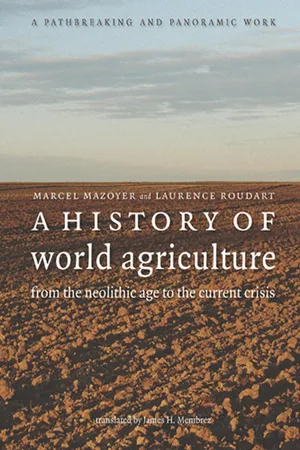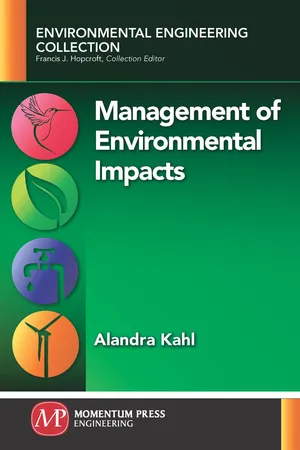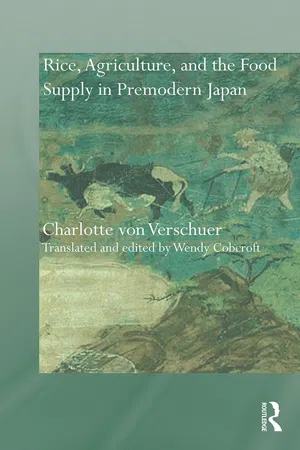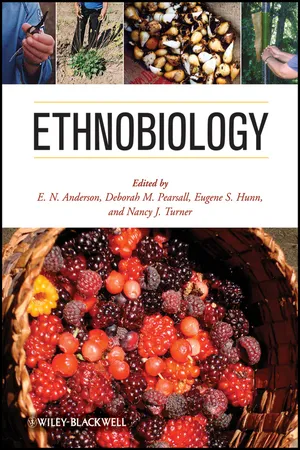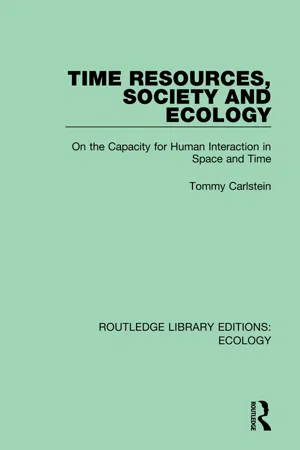Geography
Slash and Burn Agriculture
Slash and burn agriculture is a traditional farming method that involves cutting down and burning trees and vegetation to clear land for cultivation. The ash from the burned vegetation provides nutrients for the soil, allowing crops to grow. However, this method can lead to deforestation, soil erosion, and loss of biodiversity.
Written by Perlego with AI-assistance
Related key terms
Related key terms
1 of 4
Related key terms
1 of 3
8 Key excerpts on "Slash and Burn Agriculture"
- eBook - ePub
A History of World Agriculture
From the Neolithic Age to the Current Crisis
- Marcel Mazoyer, Laurence Roudart(Authors)
- 2006(Publication Date)
- Monthly Review Press(Publisher)
3Systems of Slash-and-Burn Agriculture in Forest Environments:
Deforestation and the Formation of Post-Forest Agrarian Systems
Humanity, disdainful of what was created without it, believes ... that it can develop [the planet] by destroying the slow accumulation of plant wealth that collaboration between the atmosphere and the earth had produced over thousands of centuries. Will the large ... tropical ... forest, this huge laboratory of climates, this humid and warm velvet belt of plants from which rhythmic spirals of atmospheric waves harmoniously soar, be transformed wisely, exploited with respect for humanity and nature, by taking into account its relationship with the soil and the atmosphere, or will humanity give in to the temptation to assault the earth, attack the tropical forest quickly and without thought? In the latter case, if one thinks about it, it is humanity itself which would be endangered, ... because the atmosphere would be unbalanced and instability would be introduced into climates around the whole world.—F. SHRADER , Atlas de géographie historique , 1896Slash-and-burn agriculture is practiced in diverse wooded environments: amid mature trees, in a copse, shrubby or bushy thickets, wooded savanna, etc. It is established on terrains previously cleared by grubbing, that is, cutting followed by burning but without removing the stumps. The parcels thus cleared are only cultivated for one, two, or three years, rarely more, after which they are abandoned to return to their wooded wild state for one or more decades, before being cleared and cultivated again. Systems of slash-and-burn agriculture, also called forest agrarian systems , are thus characterized by the practice of temporary cultivation alternating with long-term wooded idling, forming a rotation with a period varying from about ten to fifty years.The origin of these systems goes back to the Neolithic epoch. From that time on, they spread to most of the forests and other cultivable wooded environments of the planet, where they lasted for thousands of years. In each region of the world, this pioneer dynamic accompanied a strong demographic growth and was pursued as long as uncleared, accessible wooded terrain remained. When all these virgin reserves were used and the population density continued to increase, the frequency and intensity of clearings increased, thus beginning a dynamic of deforestation of lands cultivated by slash-and-burn techniques. Ultimately, this resulted in the impossibility of pursuing this mode of cultivation. Deforestation generally resulted in deterioration of fertility, development of a more or less serious erosion problem, depending on the biotope, and worsening of the climate, even up to the point of desertification. - eBook - ePub
- Alandra Kahl(Author)
- 2017(Publication Date)
- Momentum Press(Publisher)
3.1SLASH AND BURN FARMING IMPACTS AND CONTROLS, associated with fish poisoning, which has been positively correlated to increased surface water temperatures in tropical oceans caused by the meteorological phenomenon El Niño (Moore et al. 2008). Changes in precipitation patterns linked to climate change can also influence the expression of eutrophication. For instance, an increase in precipitation may lead to changes in stratification patterns as more freshwater in the form of runoff (and associated desalinization) is discharged into coastal oceans, and will also translate into higher nutrient fluxes (Rabalais et al. 2008).Slash and Burn Agriculture is a destructive form of agriculture that is most widely used in rainforest areas, such as the Amazon. In this method of farming, cover vegetation such as trees and forest undergrowth is clear cut, and the resulting vegetation is burned to provide fertilizer and dispose of the covering plants. The land is then planted with the crop that is desired. As this method strips the land of nutrients by removing native vegetation, the area is only suitable for crops for a short time, sometimes as little as two to three years. The soil also loses valuable nutrients through erosion during the rainy season, as the covering root structure has been removed and the soil can then wash away. Nutrients are drained from the topsoil during the rainy season due to the lack of canopy cover and are baked off during the dry season for the same reason.Farmers try to lengthen the growing period in an area by applying soil amendments such as fertilizers and pesticides once the soil is exhausted. As the fertile topsoil layer has been eroded or overplanted, these measures are short-lived. Applied fertilizers and pesticides leach off of the amended land during the rainy season and pollute local waterways. During dry seasons, dust containing pesticides are carried by the winds to affect pristine areas.In areas that are less populated, slash and burn farming can be sustainable, as the land has time to recover and regrow between periods of burning. This buffer must be at least 5 years, ideally 10. As areas of the rainforests become more populated due to migration of native tribes today, this interval is not usually reached and the land remains infertile after use. In areas of rich vegetation and diverse habitat, this loss is irreparable. - eBook - ePub
The Practice of Silviculture
Applied Forest Ecology
- Mark S. Ashton, Matthew J. Kelty(Authors)
- 2018(Publication Date)
- Wiley(Publisher)
et al., 2000).Box 31.1 Bari swidden agriculture.
Swiddening is an agroforestry system that is strongly successional. All swiddens temporarily clear a patch of forest within which agricultural crops (manioc, upland rice, vegetables) are cultivated for a number of years before the weeds become too competitive and/or the soil becomes depleted of nutrients. Cultivation is then stopped and the patch returns back to forest (Fig. 1 ). The forest that comes back can often contain trees of economic use, and some of these may have been planted. This new forest can be thinned and products are harvested before the cycle repeats itself. For that reason, swidden is also called shifting cultivation. This practice of switching between agriculture and forest on one patch of land has been its downfall in modern day land‐use planning (Padoch et al., 2007), where lands have been either demarcated for forestry or agriculture but not both (Agrawal and Sivaramakrishnan, 2001; Peluso and Vandergeest, 2001; van Noordwijk et al., 2008). This kind of planning was made particularly in forested biomes without serious consideration of what could or should be done if soils are not fertile enough to promote permanent and sedentary agriculture (Dove, 1983; Padoch et al., 2007).The Bari swidden system is an example of a complex temporal and spatial agroforestry system. The Bari are an indigenous South American people found in the Maracaibo region that includes the northeast borderlands between Colombia and Venezuela. Bari swidden agroforestry systems delineate crops by an annual or temporal zonation, rather than mixing crops together at one time. This is unusual, as most swidden systems rely upon sequential intercropping of mixtures of crops (Beckerman, 1987, 2013). In Bari swiddens, patches are usually small, less than 2.4 acres (1 ha), and typically the newly made field is planted with squash, sweet potato, and many varieties of manioc in separate areas (Beckerman, 2013). After the main crop of manioc has been harvested on several annual rotations (about 3 years), bananas and plantains are cultivated and harvested over the next 3–6‐year period. Afterwards, certain trees are interplanted such that by the 10th year, some of these trees are providing fruit. Once the weed growth has become impenetrable and difficult to cut back, the patch is abandoned to fallow. The fallow period after the final fruit tree crops have been harvested can last about 15 years before the land is cleared and the cultivation cycle resumes. Compared to other swidden systems, the Bari system is relatively simple and does not consist of a large diversity of crops (Beckerman, 2013). In other sections of this book, the Milpa swidden system of the Maya in the Yucatan, Mexico (Chapter 9 ) and the Yanomami of the Venezuelan and Brazilian Amazon (Chapter 1 - Charlotte Verschuer, Wendy Cobcroft(Authors)
- 2016(Publication Date)
- Routledge(Publisher)
Japanese archaeology has shown the existence of the practice of forest management by fire as well as the presence of edible plants in the Neolithic, from the 3rd millennium BC. Moreover, the land documents of the late medieval period (1200 – 1600) mention cases of swidden fields; and fire techniques are also attested, as we have seen, by the agricultural treatises of the Edo period (1603 – 1867). We can therefore speak of a continuity of fire agriculture over the millennia. The evidence that we have presented on the human management of edible plants in prehistoric times, far from consisting of isolated or marginal examples, only confirms a practice common to the subsequent historical periods. For the historical periods, we have discussed in this chapter several practices involving fire. The study of the administrative and poetic texts, lexicography and toponymy has enabled us to identify several techniques relating to a forest agriculture for the medieval period. Swidden farming (or assartage) involved cleaning by fire a patch of forest on a mountain side and cultivating it for a period limited to three or four years. Agri-sylviculture on a plot that had first undergone selective burning combined the cultivation of useful trees with cereal intercropping. The two systems of forest farming just mentioned were temporary and shifting. There was a third technique that cannot be regarded, strictly speaking, as a cultivation method: each year the Japanese of the early medieval period would set a running fire in wilderness areas intended for the harvesting of edible plants in order to promote their regrowth. As for land clearing aimed at permanent crops, it was done in the same way as for cleared plots intended for swidden fields- eBook - ePub
Weyerhaueser Cycle of Fire
A Brief History
- Stephen J. Pyne(Author)
- 2019(Publication Date)
- University of Washington Press(Publisher)
So can an escaped burn. A poorly executed burn may steal into the woods, or into heath or wheat, or into plots prepared by others. Typically, swiddeners surround their fields with a firebreak of cleared mineral soil; sometimes they burn fuelbreaks. The timing of burning helps, too. They can burn when the slash has dried, which is often sooner than (or at least different from) the dormant period of the surrounding woods. In such cases the moisture gradient among the fuels—the slashed plot stacked with parched wood, the forests dank with shade and dew—helps contain the fire. A spot fire that leaps beyond the plot is unlikely to spread or will creep rather than explode. During droughts, of course, this distinction disappears and escapes are many. In organic soils, the depth and breadth of draining determines the depth and extent of burning. Swiddeners can also control the burn by the way they kindle and spread the fire. They may force the flaming front to back against the wind or, if they surround a plot with flame, may compel that ring of fire to draw inward and upward, away from the exposed flanks. And of course burners patrol the flanks. Ideally, field fires are communal events. Elders and custom decide when farmers may burn, and neighbors help neighbors to do the burning. There are plenty of hands to burn quickly, to spread the fire over the whole plot, and to swat out firebrands that might catch beyond the field.Farming the Fallowed ForestSwidden comes in endless varieties. Wherever there exists a fuel, there exists the possibility of fire-fallow farming, but among the most interesting variants are those involving woods. Some forests were simply long-fallow swidden: the plots had been abandoned for so long that tall woods had sprung up. (“Jungle,” for example, is a Hindi term for “uncultivated land.” In subtopical climates, the boisterous fallow led to the dense woods and vines of popular imagery, which made “jungle” a synonym for “rainforest.”) Such long-left woods inspired a mix of logging and slashing—hauling off to mill the larger and more valuable timbers, chopping the smaller branches and lesser growth into coarse kindling for another round of burning and planting.Shorter-cycle fallows, however, were more widespread and their variants many. Some fruiting trees, like mangoes and mowrah - eBook - ePub
Fire
A Brief History
- Stephen J. Pyne(Author)
- 2011(Publication Date)
- University of Washington Press(Publisher)
What we call “agriculture” thus became a practice of selective substitution, first of species, then of landscapes. The firestick farming of aborigines selects plants from among those that already exist at a place. Ax-and-plow farming goes further and creates suitable habitats for plants that come from elsewhere. Ultimately, it may fashion whole ecosystems: the “farm” brings its own plants and animals, fixes their relationships, lays down pathways of energy and nutrients. Such a system can even be exported in defiance of climate. The European agricultural mix, for example, collected together cereals, pulses, and herbivores from the winter-rains eastern Mediterranean, then thrust them into the summer-rains regime of temperate Europe. Something had to jolt and jostle the land for it to accept so startling a change. That something, of course, was fire.Nature supplied the model. Swidden farming mimics First Fire's storm-slashed and lightning-kindled woods. It is a small step, one many aboriginal peoples took, to assist the regrowth rising in the ash or to carry other plants to the cleaned site. The next step is to create those slashed and burned plots themselves. So, likewise, pastoralism echoes the movement of wildlife as they follow seasons and the patch-burns of green, scorched, and dormant forage. Replace the wild herds with domesticated livestock; then cycle them through similar landscapes; then create those landscapes by cutting, grazing, and burning.In fire-flushed and disturbance-rich places—which most agricultural hearths were—this transition can occur piece by piece, with the domestic replacing the wild as one might replace the tiles in a mosaic. People only had to tweak fire regimes to better suit their purposes; the border between aboriginal foraging and agricultural harvesting is murky because their fire practices are almost genetically related. That frontier appears most stark and the encounter most shocking when agriculture crashes into new lands, particularly places in which fire is scarce. When sun-craving cereals and grass-munching sheep and cattle try to enter sun-starved or tranquil woods, they require a more violent wrenching. Firestick farming need only massage the environment; ax-and-plow farming requires the ability to force fire whether the landscape naturally accepts it or not. Domestication requires more than simply loosing the hearth fire into the bush, which is no better than daubing the scrub with a firestick unless fuels are there to accept it. That—the labor of creating combustibles—is, from a fire-historical perspective, what moves the practice into true agriculture. - eBook - ePub
- E. N. Anderson, Deborah Pearsall, Eugene Hunn, Nancy Turner, E. N. Anderson, Deborah Pearsall, Eugene Hunn, Nancy Turner(Authors)
- 2012(Publication Date)
- Wiley-Blackwell(Publisher)
Widely condemned for destroying forests and leaving wasteland, swidden agriculture has turned out to be a highly adapted form, which not only preserves forests but increases the percentage of species useful to humans (Balée 1994; Spencer 1966; Wilken 1987). Many local forms of swiddening exist, differing in management details. Southeast Asia in general is home to amazingly sophisticated and intricate swidden systems, which often involve tree cropping, home gardens, small permanent fields, forest gardens, and several other forms of cultivation as well as swidden fields (Conklin 1957, 1981, 2007; Klee 1980; Spencer 1966; Ayoe Wang, research in progress). Similarly, famous work in South America was done by Darrell Posey (2004) on the Kayapo. Among the most specialized and complex, and also among the best studied, is the milpa agriculture of tropical Mexico (E.N. Anderson 2005b; Atran 1999; Fedick 1996; Ford and Emery 2008; Gomez-Pompa 1987; Gomez-Pompa et al. 2003; Stuart 1978; Terán and Rasmussen 1993; Terán et al. 1998). The teak forests of southeast Asia and the fruit tree-rich forests of tropical America are products of forest management by swidden farmers. Swiddening destroys forests only when done carelessly, often in pioneer environments, or when population density builds up rapidly. The latter situation is common in modern situations in which swiddeners are not allowed to move or are deprived of much of their traditional land base. HOMEGARDENS Considerable ethnobiological research has concerned homegardens, because they tend to preserve much diversity, especially of minor plants and animals, including medicinals, ornamentals, and other special-purpose items. Their role in domesticating plants was emphasized in Edgar Anderson’s classic Plants, Man and Life (1952). Homegardens are vital to many of the world’s peoples, providing essential nutrients and cash income as well as household amenities - eBook - ePub
Time Resources, Society and Ecology
On the Capacity for Human Interaction in Space and Time
- Tommy Carlstein(Author)
- 2019(Publication Date)
- Routledge(Publisher)
shifting cultivation itself gives a hint of spatio-temporal structure and variability. As with food collectors, shifting cultivators must be mobile in space and time, but with different frequencies, durations and relative locations. Not only are individuals mobile but the settlement system itself undergoes spatial changes and shifts which reflect on society and habitat. Some of the previously outlined mechanisms are found also with shifting cultivators but in new combinations and with different magnitudes and significance. When stationary plants are cultivated, land (space-time) requirements also become more obvious perhaps and the cultural landscape more visible. In this context, carrying capacity and packing problems in a settlement space-time budget are more easily represented, although they are crucial in all systems and ecotechnologies.Conklin (1961) gives the following minimum definition for shifting or swidden cultivation: ‘any continuing agricultural system in which impermanent clearings are cropped for shorter periods in years than they are fallowed’. Pelzer (1945) has given a more inclusive definition by listing the following characteristics:- 1) rotation of fields rather than crops,
- 2) clearing by means of fire,
- 3) absence of draught animals and of manuring,
- 4) use of human labour only,
- 5) employment of dibble-stick or hoe, and
- 6) shorter periods of soil occupancy altering with long fallow periods.
Shifting agriculture has several names such as swidden, slash-andbum, field-forest rotation, and cut-and-bum agriculture. The term swidden was introduced by Izikowitz (1957:7) using an obsolete English word and it has since become widely used. It illustrates the most marked feature of this cultivation system: the use of fire as a tool for clearing and as a method of fertilization. The term ‘shifting’ emphasizes the space-time feature of relative impermanence of land occupation. It may sound objectionable to some to call this type of cultivation system ‘agriculture’ instead of horticulture or gardening, since ‘agri’-culture is generally associated with permanent fields under plough tillage. All the same, at the general level of analysis employed here, this distinction will be dropped.
Index pages curate the most relevant extracts from our library of academic textbooks. They’ve been created using an in-house natural language model (NLM), each adding context and meaning to key research topics.
Explore more topic indexes
Explore more topic indexes
1 of 6
Explore more topic indexes
1 of 4
